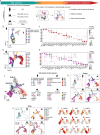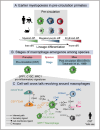Integrative cross-species transcriptome analysis reveals earlier occurrence of myelopoiesis in pre-circulation primates compared to mice
- PMID: 39397246
- PMCID: PMC11668956
- DOI: 10.24272/j.issn.2095-8137.2024.173
Integrative cross-species transcriptome analysis reveals earlier occurrence of myelopoiesis in pre-circulation primates compared to mice
Abstract
Hematopoiesis originates in the yolk sac, which forms prior to the establishment of blood circulation and exhibits distinct developmental processes between primates and mice. Despite increasing appreciation of yolk sac hematopoiesis for its lifelong contribution to the adult hematopoietic system and its regulatory roles in organogenesis, cross-species differences, particularly before the onset of blood circulation, remain incompletely understood. In this study, we constructed an integrative cross-species transcriptome atlas of pre-circulation hematopoiesis in humans, monkeys ( Macaca fascicularis), and mice. This analysis identified conserved populations between primates and mice, while also revealing more differentiated myeloid, erythroid, and megakaryocytic lineages in pre-circulation primates compared to mice. Specifically, SPP1-expressing macrophages were detected in primates before the onset of blood circulation but were absent in mice. Cell-cell communication analysis identified CSF1 + extraembryonic mesoderm cells as a potential supportive niche for macrophage generation, with ligand-receptor interactions between macrophages and other cell populations in the human yolk sac. Interestingly, pre-circulation SPP1 + macrophages exhibited hallmark signatures reminiscent of a macrophage subset that positively regulates hematopoietic stem cell generation. Our findings provide a valuable cross-species resource, advancing our understanding of human pre-circulation yolk sac hematopoiesis and offering a theoretical basis for the regeneration of functional blood cells.
最早的造血事件发生于血液循环建立之前的卵黄囊,而卵黄囊的发育过程在物种间存在显著差异。越来越多的证据表明卵黄囊造血能够终生贡献成体造血系统,以及在器官形成过程中发挥调控作用,这凸显了卵黄囊造血的重要性。但对早期卵黄囊造血事件的物种间异同,特别是在血液循环开始之前的具体差异,目前的认识仍相当有限。在该研究中,我们构建了人、食蟹猴和小鼠循环前造血的跨物种转录组整合图谱。物种间比对分析识别了灵长类与小鼠间互相对应的转录组特征相似的造血群体。然而,与小鼠相比,灵长类循环前造血产物中能够观察到更加分化的髓系、巨核和红系造血群体。例如,灵长类在血液循环建立以前已经能够检测到表达 SPP1的巨噬细胞,而小鼠中则没有。细胞间互作分析表明,特异表达 CSF1的卵黄囊胚外中胚层细胞亚群可能为巨噬细胞生成提供了支持微环境。相应地,这群巨噬细胞也可能通过特定的配体-受体互作,介导了对卵黄囊中其他细胞群体的调控。有趣的是,灵长类循环前巨噬细胞群体展现出了与小鼠胚胎背主动脉巨噬细胞亚群相似的分子特征,这些小鼠巨噬细胞被证明能够正向调控造血干细胞产生。综上,我们的研究为理解人类卵黄囊循环前造血发育和功能性血细胞再生提供了新见解。.
Keywords: Hematopoiesis; Integrative analysis; Macrophage; Single-cell RNA sequencing; Yolk sac.
Conflict of interest statement
The authors declare that they have no competing interests.
Figures




Similar articles
-
Hematopoiesis in the yolk sac: more than meets the eye.Exp Hematol. 2005 Sep;33(9):1021-8. doi: 10.1016/j.exphem.2005.06.012. Exp Hematol. 2005. PMID: 16140150 Review.
-
Development of erythroid and myeloid progenitors in the yolk sac and embryo proper of the mouse.Development. 1999 Nov;126(22):5073-84. doi: 10.1242/dev.126.22.5073. Development. 1999. PMID: 10529424
-
CD34+ endothelial cell lines derived from murine yolk sac induce the proliferation and differentiation of yolk sac CD34+ hematopoietic progenitors.Blood. 1995 Dec 15;86(12):4454-67. Blood. 1995. PMID: 8541534
-
Definitive Hematopoiesis in the Yolk Sac Emerges from Wnt-Responsive Hemogenic Endothelium Independently of Circulation and Arterial Identity.Stem Cells. 2016 Feb;34(2):431-44. doi: 10.1002/stem.2213. Epub 2015 Oct 23. Stem Cells. 2016. PMID: 26418893 Free PMC article.
-
Yolk-sac hematopoiesis: the first blood cells of mouse and man.Exp Hematol. 2001 Aug;29(8):927-36. doi: 10.1016/s0301-472x(01)00669-5. Exp Hematol. 2001. PMID: 11495698 Review.
References
MeSH terms
LinkOut - more resources
Full Text Sources
Research Materials
Miscellaneous
